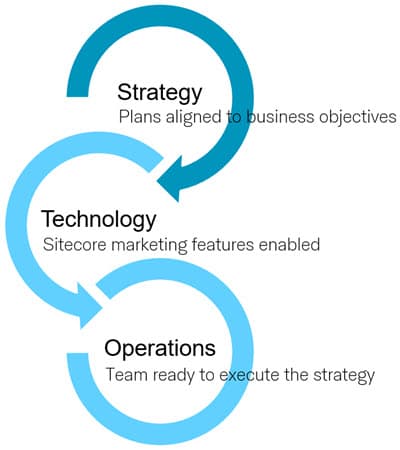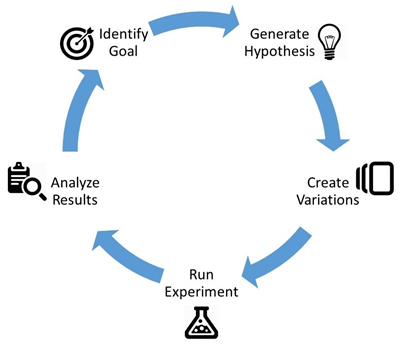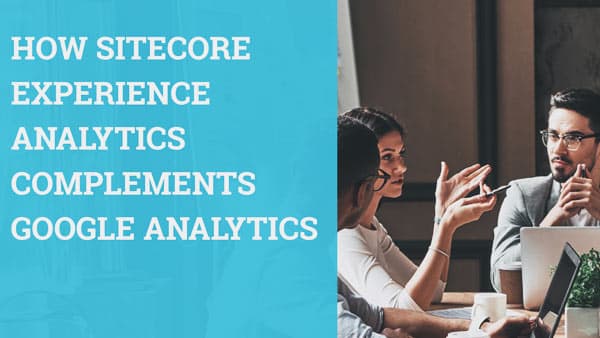
Are you ready for Sitecore's marketing capabilities?




Aug 26, 2020
Seeking to achieve digital transformation, organizations arm themselves with the best martech. But often, transformation isn't achieved. This happens when the need for a roadmap beyond the implementation project is overlooked.
Many companies acquire the Sitecore Experience Platform looking forward to benefiting from its promising experience marketing features. Often with the fake believe that once the implementation project is completed and their newly redesigned website launched, their job is done. That's not the case.
The offering of a relevant contextualized journey to your customers is supported by the new platform: Sitecore. But digital transformation is not a finite project. Achieving this level of maturity in an organization is not a project but a business transformation. To ensure the return on the investment made on the technology they must get strategically and operationally ready beforehand.
The Sitecore Experience Platform’s marketing features offer a very complete toolset to digital marketers:
- Experience Profile — data analysis at the individual level. User activity is tracked from the minute they visit your site as anonymous contacts and later merged into their identified user profile.
- Experience Analytics — data analysis with a focus on visitor’s Engagement Value, rather than click-through rates and conversion totals.
- Path Analyzer— a map that shows the sequential paths that visitors take as they navigate through your website. You can see the paths that users take while interacting with campaigns and trigger goals and outcomes.
- xConnect — API that allows for search, retrieval, and insertion of data into xDB. Sitecore xConnect helps you to connect data together, regardless of where the data is coming from or what format it’s in.
- Personalization — an opportunity for both business and customer. Digital marketers can show their site visitors relevant content, as well as drive them to conversion points.
- Testing — technology that allows you to create variations of content randomly presented to your visitors while you measure conversions towards a specified goal. This practice will help you determine what’s working and what’s not, generate new hypotheses, and test again. As an end result, you will optimize your strategy and your visitors’ experience based on customer data.
- Federated Experience Manager (FXM) - enables you to personalize content and track goals across web properties that you own but haven’t been implemented in Sitecore yet.
- Marketing Automation — empowers marketers to control how a website responds to visitors by defining automated system responses to user interactions. For example, it could automatically email a user who abandoned the shopping cart with items in it or increase the engagement value of a visitor who completes the registration form.
- Email Experience Manager — communication that takes its cues from the history of user behavior on your website and other channels, goal completions, and captured profile data to deliver a more personalized and seamless conversation.
- Forms — drag-and-drop form builder. Allows for sections, multi-page forms, fields validation, and styling, etc.
- Cortex — Sitecore features that combine to enable “Contextual Intelligence”: xDB, xConnect, and machine learning — smart algorithms process your data, surface opportunities, and trigger intelligent responses.
It is very likely that these appealing features influenced your decision when you chose Sitecore as MarTech. But getting started with a new tool or new features of this advanced nature can be hard. How do you get started?
You start by assessing your organization’s readiness to leverage marketing features. Once you achieve readiness and have a proper plan in place, you execute it.
In this post, I’ll focus on providing a guide to determine whether you are ready to start. We will consider three key areas:
Strategic Readiness— You have defined how your organization will leverage marketing features and have a plan to measure success over time.
Technical Readiness— Your Sitecore solution’s marketing features are enabled.
Operational Readiness— Your team is trained to execute the strategy within the experience platform.

Strategic Readiness
It all starts with a plan. Before jumping into implementation, you must have a strategy in place. Depending on the maturity of your organization’s marketing, your plans can be more or less ambitious. Adopting a crawl, walk, run approach will allow you to start small and grow from the experience. Sitecore Experience Analytics will help you measure the impact of your marketing efforts.
Few organizations have reached the kind of digital marketing maturity considered ideal. Don’t worry if yours isn’t one of them. Strategic readiness isn’t something you have or you don’t — it’s a process you grow into. The farther along you are, the more you can leverage the powerful features and functionality within Sitecore.
Do You Have a Vision and a Plan?
Digital Marketing Plan — Make sure that your digital marketing goals are aligned with general marketing goals, your business objectives, and your organization’s strategic objectives.
Digital Marketing Goals and Key Performance Indicators (KPIs) — Identifying marketing goals is fundamental to track Engagement Value. Additionally, you should have a KPI defined for the most important goals and for each marketing objective.
Sitecore marketing features — Your strategy must clearly outline what marketing features you will start with. Don’t hesitate to get help from consultants if you need guidance determining what features are best to get you started.
Timeline — Defining a timeline will help you visualize your expectations over time. Lining up your plan and adjusting it to be realistic and achievable will allow you to prepare better.
Do You Know Your Customer?
Personas — To leverage personalization you must first get to know who your visitors are. Knowing the who, what, when, where, why, and how is the first step to designing your personalization scenarios.
Personalization Hypotheses — You need plans and ideas about the marketing messages, assets and offers that will move each unique prospect to the next stage of the relationship.
Do You Think of Value Over Volume?
Success Measuring — Traditional analytics are driven by volume: number of total visits and repeat visits, total length of visits, number of downloads and so on. But to use the Sitecore Experience Platform effectively, you’ll need to start thinking about value per visit. As a paradigm shift in evaluating marketing success, value per visit has been proven by Sitecore and other sophisticated web analytics to be a reliable proxy for digital marketing ROI.
Engagement Value — The key insights this metric provides is about the quality of the visit and the conversion potential. Engagement Value takes two factors into account: (1) how effective your marketing is in reaching prospects, and (2) how relevant it is to the customer. Measuring the value of visits rather than the number of visits gives you a far more accurate picture of the effectiveness of a given campaign or marketing asset and helps marketers understand the importance and quality of traffic in relation to the website and marketing efforts being executed.
EV Scale — Being able to score your marketing activities is critical to Sitecore’s Experience Analytics, and it’s something you must have ready to go before you use additional marketing functionality.
Do You Have an Experimentation Process?
Digital Marketing Processes — Sitecore’s marketing features will support the implementation of your web optimization strategies, but it is your duty to make the process optimal. Your team must continuously generate hypotheses on how to improve your website towards achieving marketing goals and KPIs, implement them, analyze the resulting analytics, make changes and refinements, and iterate. The key to success lies in completing the cycle and starting over every time, while adapting and evolving to better meet your visitors’ expectations.

Technical Readiness
Sitecore requires a robust and high-performance solution architecture to support the marketing capabilities of the platform. Before implementing marketing features, you must determine your “technical readiness” by evaluating your infrastructure, solution architecture, customizations, and integrations with modules and third-party software.
Answered thoughtfully, these questions can provide a clear sense of how ready you really are to use the specific marketing features you hope to implement and what you need to do to get there. As you make a remediation plan, you can prioritize tasks — not every issue will need to be addressed immediately. You’ll need to take care of certain tasks before you begin, but others that affect only your ability to run highly sophisticated marketing features can wait until you’ve had some experience with the system.
Is Your Solution Ready?
It is possible that your solution architecture needs to be improved or upgraded before you are able to use Sitecore’s marketing features effectively.
Sitecore Version — It is recommended that a version of Sitecore 8.2 or higher is in place.
xDB — In versions previous to 9.x, xDB runs in Mongo. After v9 it can be hosted in MySQL as well. Sitecore’s marketing features are fueled by the data collected in xDB. Having xDB installed and configured is a prerequisite for marketing features.
Standards and Best Practices — Proper implementation of data templates and components will ensure a smooth editorial experience. Following standards and best practices also has a positive impact on your solution’s performance.
Experience Editor — The Experience Editor is required to implement content profiling and facilitates the implementation of testing and personalization. It must be enabled and properly configured for you to leverage Sitecore marketing features. If your team doesn't use it, they must be trained on using this tool to be able to optimize the site.
Placeholder Settings — Their definition ensures that the editor is prompted to select the right component type while using the Experience Editor.
Data Sources — Swapping data sources is required to implement personalization. Make sure the data sources can be changed from the Experience Editor.
Page and Components Granularity — Any page area to be personalized must be implemented as a component. Do your pages have the appropriate level of modularity for the goals you want to achieve?
Is Your Infrastructure Ready For Sitecore’s Marketing?
Ensuring a high performing solution with marketing features enabled requires more than just deploying the minimum Sitecore hardware and hosting environment.
Infrastructure Roles and Services — Your Sitecore Solution Architect must ensure a proper configuration of the servers’ roles and services (Content Delivery (CD), Content Management (CM), xConnect, Email Experience Marketing, etc.) to guarantee optimal functioning and performance of marketing features.
“Right-Sized” Environment — It is fundamental to have the right configurations in place to support the exponential use and growth of databases to support the analytics that fuel the marketing capabilities. Even if the size is right for your current load, will it be in 12 months?
Data Retention — As your data collection increases, so will the cost of storage. Defining upfront how much data you need to hang on to, and how much should you move off your servers, will help you avoid incurring unnecessary costs. Ideally, you should have migration strategies in place before getting started with Sitecore’s marketing features.
Do You Need Data Integration?
Customer Data Outside Sitecore — xConnect (available in Sitecore 9.x) opens a world of possibilities in terms of the variety of data that can be pulled into Sitecore. It is likely that you already have a CRM in place; an external data store or a spreadsheet filled with client data. Feeding Sitecore with these external data sources will boost your Sitecore marketing possibilities. You will be able to leverage that additional data to better understand your customers and create relevant experiences for them. Consider the time required to implement any integration that might be required.
Operational Readiness
Operational readiness is often the hardest to achieve. It involves hiring resources or shifting priorities of team members to work on marketing features. To ensure operational readiness, you must have a properly trained team, a content strategy, and at least a basic understanding of how to transform analytics into actionable insights. But one thing is certain, organizations who have completed their digital transformation to Sitecore’s marketing features have seen an excellent return on their investment.
Are you ready to get started?
Team Composition — Make sure you have the right team in place to plan the strategy and execute it. Your team must be able to produce a marketing plan, implement it in Sitecore, and evaluate the results by interpreting the site analytics.
Sitecore Editing Features — Knowledge of Sitecore editing is a must-have to be able to implement Sitecore’s marketing capabilities. Do your team uses editing tools on a daily basis? Which of Sitecore’s editing tools does your team use?
- Experience Editor
- Content Editor
- Media Library
- Workbox
Training — Make sure your team members receive in-person or online editorial and marketing training. Once people understand how to implement against certain capabilities the more likely they are to be used and implemented across a site.
Strategy Planning Process — Plan and revise your strategy regularly. First, understand what conversations need to be had and who needs to be involved, then schedule the required meetings. Secondly, define planning documents and deliverables, then work on completing them. Lastly, hold work sessions to close the knowledge gap and provide a level of understanding that is often missed during more drawn out planning engagements.
Final Thoughts
Seeking to achieve digital transformation, organizations arm themselves with the best MarTech. But often, transformation isn’t achieved. This happens when the need for a roadmap beyond the implementation project is overlooked.
Understanding all the pieces that must work together once the technology is in place will help you prepare for what is next.
Having a strategy beyond implementation will prepare you for success in the era of data-driven marketing.





